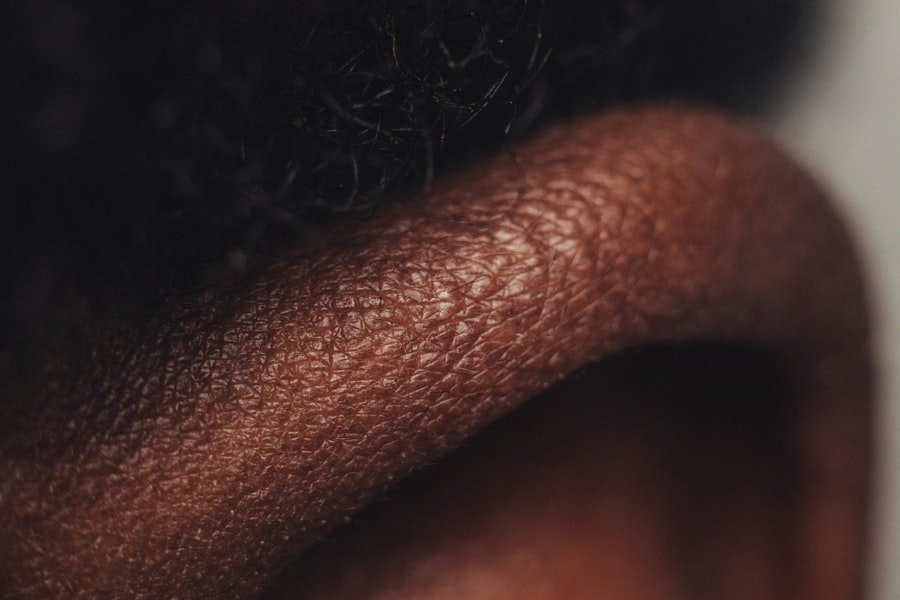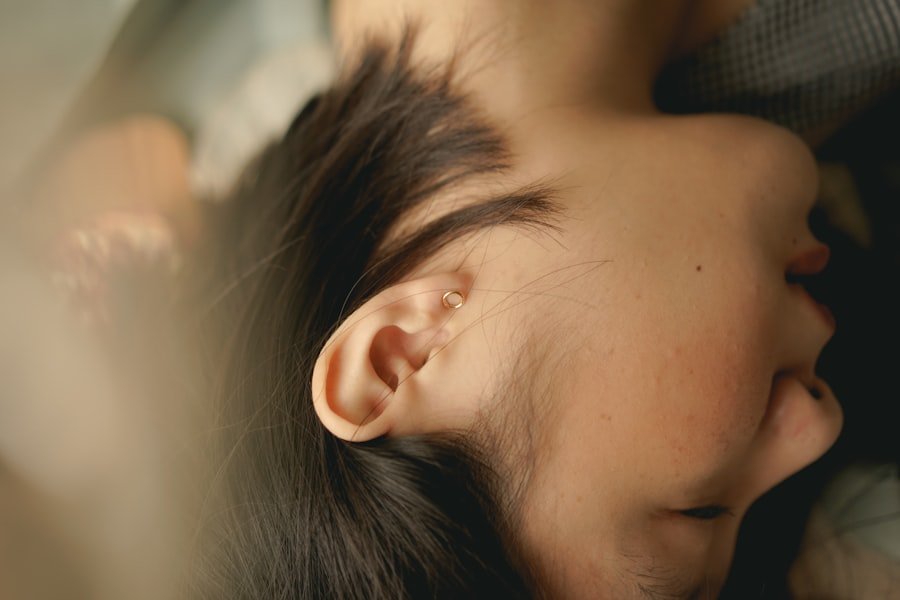Cauliflower ear is a condition that arises from trauma to the outer ear, leading to a deformity that resembles the bumpy surface of a cauliflower. This condition is most commonly associated with contact sports, where repeated blows to the ear can cause blood to accumulate between the cartilage and the skin. Over time, if left untreated, this accumulation can harden and lead to the characteristic lumpy appearance.
The term “cauliflower ear” itself evokes a vivid image, and it serves as a reminder of the physical toll that certain sports can take on athletes. As we delve deeper into the anatomy of cauliflower ear, we find that it primarily affects the auricle, or the outer part of the ear. The injury typically occurs when blood vessels in the ear are ruptured, resulting in a hematoma.
If this hematoma is not properly drained, it can lead to fibrosis and permanent changes in the ear’s structure. For many athletes, especially wrestlers and rugby players, cauliflower ear becomes a badge of honor, symbolizing their dedication to their sport. However, it is essential to understand that this condition can have lasting effects on both appearance and hearing.
Key Takeaways
- Cauliflower ear is a condition where the outer ear becomes deformed and swollen due to trauma or injury.
- Common causes of cauliflower ear include repeated trauma to the ear, such as from contact sports or physical altercations.
- Symptoms of cauliflower ear include swelling, pain, and a distorted appearance of the ear.
- Seeking medical attention is important to prevent complications such as infection and permanent deformity.
- Treatment options for cauliflower ear may include draining the fluid, applying pressure dressings, and in severe cases, surgical intervention.
Common Causes of Cauliflower Ear
The most prevalent cause of cauliflower ear is blunt trauma to the ear, which is often experienced in contact sports such as wrestling, boxing, rugby, and mixed martial arts. In these sports, athletes frequently engage in grappling or striking, which can lead to direct hits to the ear. The force of these impacts can cause blood vessels to rupture, resulting in swelling and bruising.
As we participate in these activities, we must be aware of the risks involved and take appropriate precautions. Another common cause of cauliflower ear is friction or repeated pressure on the ear. This can occur in sports like wrestling, where athletes often find themselves in positions that put strain on their ears.
The constant rubbing against mats or opponents can lead to irritation and subsequent injury. Additionally, even non-contact activities such as cycling or skateboarding can contribute to this condition if an individual falls and lands on their side. Understanding these causes helps us appreciate the importance of preventive measures.
Recognizing the Symptoms of Cauliflower Ear

Recognizing the symptoms of cauliflower ear is crucial for early intervention and treatment. Initially, we may notice swelling and tenderness in the affected ear following an injury. This swelling can develop rapidly, often within hours of the trauma.
As we observe these early signs, it is essential to monitor for any changes in color or temperature, as these can indicate complications.
As time progresses without treatment, we may begin to see the characteristic deformity associated with cauliflower ear.
The once smooth contour of the ear becomes lumpy and irregular, resembling a cauliflower head.
This change in appearance can be distressing for many individuals, leading to self-consciousness and concerns about how they are perceived by others. Additionally, some may experience discomfort or pain in the affected area, which can further complicate daily activities.
The Importance of Seeking Medical Attention
Seeking medical attention promptly after an injury is vital in preventing the progression of cauliflower ear. When we experience trauma to the ear, it is essential to consult a healthcare professional who can assess the extent of the injury. Early intervention often involves draining any accumulated blood from the hematoma, which can significantly reduce the risk of permanent deformity.
Ignoring symptoms or delaying treatment can lead to more severe complications down the line. As we navigate our lives, we must prioritize our health and well-being by recognizing when professional help is needed. By doing so, we not only protect our physical appearance but also safeguard our hearing and overall quality of life.
Treatment Options for Cauliflower Ear
When it comes to treating cauliflower ear, several options are available depending on the severity of the condition. For minor cases where swelling is present but no significant deformity has developed, conservative measures such as ice application and rest may be sufficient. These methods help reduce inflammation and alleviate discomfort while allowing the body to heal naturally.
In more severe cases where a hematoma has formed, medical intervention becomes necessary. A healthcare professional may perform an aspiration procedure to drain the accumulated blood from the ear. This process involves using a needle and syringe to remove fluid, which can help restore normal shape and function to the ear.
Following drainage, it is crucial for us to follow post-procedure care instructions diligently to minimize the risk of recurrence.
Preventing Cauliflower Ear

Prevention is always better than cure, especially when it comes to conditions like cauliflower ear. For those involved in contact sports, wearing protective headgear is one of the most effective ways to reduce the risk of injury. These helmets or headgear are designed specifically to shield the ears from impact and friction during play.
Additionally, we should be mindful of our training techniques and practices. Engaging in proper warm-up routines and using safe sparring methods can help minimize trauma to the ears. Coaches and trainers play a vital role in educating athletes about these preventive measures, ensuring that everyone understands the importance of protecting their bodies while pursuing their passions.
Complications of Untreated Cauliflower Ear
If left untreated, cauliflower ear can lead to several complications that extend beyond mere cosmetic concerns. One significant issue is the potential for chronic pain or discomfort in the affected area. As we continue our activities without addressing the injury, we may find ourselves dealing with persistent soreness that interferes with our performance.
Moreover, untreated cauliflower ear can result in hearing loss due to changes in the ear’s structure or damage to surrounding tissues. This loss can be gradual but may significantly impact our ability to communicate effectively or engage in social situations. By recognizing these potential complications early on, we can take proactive steps toward treatment and recovery.
The Role of Protective Gear in Preventing Cauliflower Ear
Protective gear plays a crucial role in preventing cauliflower ear among athletes engaged in contact sports. Headgear designed specifically for wrestling or boxing provides a barrier that absorbs impact and reduces friction on the ears during competition or training sessions. By wearing this gear consistently, we can significantly lower our risk of sustaining injuries that could lead to cauliflower ear.
In addition to headgear, other forms of protective equipment such as helmets for rugby or football also contribute to safeguarding our ears from trauma. It is essential for us as athletes to prioritize our safety by investing in high-quality protective gear that fits properly and offers adequate coverage. By doing so, we not only protect ourselves from cauliflower ear but also enhance our overall performance by minimizing distractions caused by pain or discomfort.
Managing Pain and Discomfort Associated with Cauliflower Ear
For those who have already developed cauliflower ear or are experiencing discomfort from an injury, managing pain becomes a priority. Over-the-counter pain relievers such as ibuprofen or acetaminophen can provide relief from inflammation and soreness associated with this condition. However, it is essential for us to consult with a healthcare professional before starting any medication regimen.
In addition to medication, applying ice packs to the affected area can help reduce swelling and numb pain temporarily. We should also consider gentle massage techniques around the ear to promote circulation and alleviate tension.
By incorporating these strategies into our daily routines, we can better manage any discomfort while allowing our bodies time to heal.
Surgical Options for Severe Cases of Cauliflower Ear
In severe cases where cauliflower ear has progressed significantly or resulted in permanent deformity, surgical intervention may be necessary. Surgical options typically involve reconstructive procedures aimed at restoring the ear’s natural shape and function. These surgeries may include excision of fibrous tissue or grafting techniques that utilize cartilage from other areas of the body.
While surgery can be an effective solution for correcting deformities caused by cauliflower ear, it is essential for us to weigh the risks and benefits carefully. Recovery from surgical procedures often requires time and patience as we navigate rehabilitation processes aimed at restoring full function to our ears.
Living with Cauliflower Ear: Coping Strategies and Support
Living with cauliflower ear can present unique challenges that extend beyond physical appearance. Many individuals may experience feelings of self-consciousness or anxiety about how others perceive them due to their condition. It is crucial for us to seek support from friends, family members, or even support groups who understand what we are going through.
Coping strategies such as focusing on our strengths and accomplishments outside of physical appearance can help shift our mindset toward a more positive outlook. Engaging in activities that boost self-esteem—whether through sports achievements or personal interests—can also provide a sense of fulfillment beyond our physical attributes. By fostering a supportive environment and embracing our individuality, we can navigate life with confidence despite any challenges posed by cauliflower ear.
In conclusion, understanding cauliflower ear—its causes, symptoms, treatment options, and preventive measures—empowers us as individuals engaged in contact sports or activities prone to this condition. By prioritizing our health through education and proactive measures, we can protect ourselves from potential complications while continuing to pursue our passions with confidence.
If you are interested in learning more about skin conditions and treatments, you may want to check out this article on psoriasis and psoriatic arthritis. Psoriasis is a chronic skin condition that causes red, scaly patches to appear on the skin, while psoriatic arthritis is a type of arthritis that affects some people with psoriasis. Dr. Trisha Khanna provides valuable information on the causes, symptoms, and treatment options for these conditions.
FAQs
What is cauliflower ear?
Cauliflower ear, also known as perichondrial hematoma, is a condition that occurs when the external part of the ear is hit or receives a significant impact, causing the ear to become swollen and deformed.
What are the causes of cauliflower ear?
Cauliflower ear is commonly caused by trauma to the ear, such as a direct blow or repeated friction to the ear. This can occur in contact sports like wrestling, rugby, and mixed martial arts, as well as other activities where the ear is at risk of injury.
What are the symptoms of cauliflower ear?
Symptoms of cauliflower ear include swelling, pain, and deformity of the ear. The affected ear may also feel warm to the touch and may have bruising or discoloration.
How is cauliflower ear treated?
Treatment for cauliflower ear typically involves draining the accumulated blood or fluid from the affected area. This may be done through aspiration or surgical drainage. In some cases, a compression dressing may be applied to the ear to prevent further accumulation of blood or fluid.
Can cauliflower ear be prevented?
Cauliflower ear can be prevented by wearing protective headgear during activities where the ear is at risk of injury, such as contact sports. Prompt treatment of any ear injuries can also help prevent the development of cauliflower ear.


